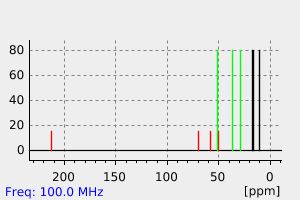4-Chlorbornanon | 55784-69-5
中文名称
——
中文别名
——
英文名称
4-Chlorbornanon
英文别名
4-Chloro-1,7,7-trimethylbicyclo[2.2.1]heptan-2-one
CAS
55784-69-5
化学式
C10H15ClO
mdl
——
分子量
186.681
InChiKey
CVWPMLBZPBDOGG-UHFFFAOYSA-N
BEILSTEIN
——
EINECS
——
-
物化性质
-
计算性质
-
ADMET
-
安全信息
-
SDS
-
制备方法与用途
-
上下游信息
-
文献信息
-
表征谱图
-
同类化合物
-
相关功能分类
-
相关结构分类
计算性质
-
辛醇/水分配系数(LogP):2.2
-
重原子数:12
-
可旋转键数:0
-
环数:2.0
-
sp3杂化的碳原子比例:0.9
-
拓扑面积:17.1
-
氢给体数:0
-
氢受体数:1
SDS
上下游信息
-
下游产品
中文名称 英文名称 CAS号 化学式 分子量 樟脑 1,7,7-trimethyl-bicyclo[2.2.1]heptan-2-one 76-22-2 C10H16O 152.236
反应信息
-
作为反应物:参考文献:名称:Intramolecular Electron Transfer Reactions Catalyzed by .alpha.-Oxo and .beta.-Oxo Substituents in the 1-Chlorobicyclo[2.2.1]heptane System摘要:Efficient intramolecular ET catalysis in S(RN)1 reactions was observed when a carbonyl group is present in 1-chlorobicyclo[2.2.1]heptane in the alpha or beta position. 1-Chloro-3,3-dimethyl-2-oxobicyclo[2.2.1]heptane (1) and 4-chloro-1,7,7-trimethyl-2-oxobicyclo[2.2.1]heptane (4) reacted with diphenylphosphide ion (Ph(2)P(-)) as nucleophile in liquid ammonia under photostimulation to give the substitution products in good yields, together with very small amounts of the reduction product. The substitution products were not observed in dark conditions, and the photostimulated reactions were inhibited by p-dinitrobenzene. These reactions are proposed to proceed via the S(RN)1 mechanism. In competition experiments, the reactivity ratio of 1 to 4 was 2.8, whereas the ratio of 1-chloro-3,3-dimethyl-2-oxobicyclo[2.2.2]octane (8) to 4 was 1.1. On the other hand, 1-chloro-2-methylene-3, 3-dimethylbicyclo[2.2.1]heptane (7) was unreactive under these experimental conditions. It then seems to follow that when there is a carbonyl group in these bicyclic compounds, in the a or beta position, they react by the S(RN)1 mechanism, and the overall reactivity is similar, but when the C=O is replaced by a C=C, the substrate did not react in these experimental conditions. These results are in agreement with MO calculations, in which the LUMO of compounds 1, 4, and 8 belongs to the pi* MO of the C=O group, with similar energies, and is lower than the pi* MO of 7.DOI:10.1021/jo00109a035
表征谱图
-
氢谱1HNMR
-
质谱MS
-
碳谱13CNMR
-
红外IR
-
拉曼Raman
-
峰位数据
-
峰位匹配
-
表征信息
同类化合物
(5β,6α,8α,10α,13α)-6-羟基-15-氧代黄-9(11),16-二烯-18-油酸
(3S,3aR,8aR)-3,8a-二羟基-5-异丙基-3,8-二甲基-2,3,3a,4,5,8a-六氢-1H-天青-6-酮
(2Z)-2-(羟甲基)丁-2-烯酸乙酯
(2S,4aR,6aR,7R,9S,10aS,10bR)-甲基9-(苯甲酰氧基)-2-(呋喃-3-基)-十二烷基-6a,10b-二甲基-4,10-dioxo-1H-苯并[f]异亚甲基-7-羧酸盐
(1aR,4E,7aS,8R,10aS,10bS)-8-[((二甲基氨基)甲基]-2,3,6,7,7a,8,10a,10b-八氢-1a,5-二甲基-氧杂壬酸[9,10]环癸[1,2-b]呋喃-9(1aH)-酮
(+)顺式,反式-脱落酸-d6
龙舌兰皂苷乙酯
龙脑香醇酮
龙脑烯醛
龙脑7-O-[Β-D-呋喃芹菜糖基-(1→6)]-Β-D-吡喃葡萄糖苷
龙牙楤木皂甙VII
龙吉甙元
齿孔醇
齐墩果醛
齐墩果酸苄酯
齐墩果酸甲酯
齐墩果酸溴乙酯
齐墩果酸二甲胺基乙酯
齐墩果酸乙酯
齐墩果酸3-O-alpha-L-吡喃鼠李糖基(1-3)-beta-D-吡喃木糖基(1-3)-alpha-L-吡喃鼠李糖基(1-2)-alpha-L-阿拉伯糖吡喃糖苷
齐墩果酸 beta-D-葡萄糖酯
齐墩果酸 beta-D-吡喃葡萄糖基酯
齐墩果酸 3-乙酸酯
齐墩果酸 3-O-beta-D-葡吡喃糖基 (1→2)-alpha-L-吡喃阿拉伯糖苷
齐墩果酸
齐墩果-12-烯-3b,6b-二醇
齐墩果-12-烯-3,24-二醇
齐墩果-12-烯-3,21,23-三醇,(3b,4b,21a)-(9CI)
齐墩果-12-烯-3,21,23-三醇,(3b,4b,21a)-(9CI)
齐墩果-12-烯-3,11-二酮
齐墩果-12-烯-2α,3β,28-三醇
齐墩果-12-烯-29-酸,3,22-二羟基-11-羰基-,g-内酯,(3b,20b,22b)-
齐墩果-12-烯-28-酸,3-[(6-脱氧-4-O-b-D-吡喃木糖基-a-L-吡喃鼠李糖基)氧代]-,(3b)-(9CI)
齐墩果-12-烯-28-酸,3,7-二羰基-(9CI)
齐墩果-12-烯-28-酸,3,21,29-三羟基-,g-内酯,(3b,20b,21b)-(9CI)
鼠特灵
鼠尾草酸醌
鼠尾草酸
鼠尾草酚酮
鼠尾草苦内脂
黑蚁素
黑蔓醇酯B
黑蔓醇酯A
黑蔓酮酯D
黑海常春藤皂苷A1
黑檀醇
黑果茜草萜 B
黑五味子酸
黏黴酮
黏帚霉酸







